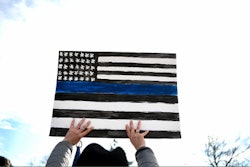At long last, the Polar Vortex—a swirling mass of brutally cold air that normally remains above the Arctic Ocean, but occasionally slips from its orbit and spins southward toward North America—has retreated back to the North Pole.
The cold weather has been nothing short of historic. At one point, temperatures in Chicago reached negative 45 degrees Fahrenheit, making it colder than Antarctica on that same day. Temperatures in places like Minneapolis and Detroit fell to as low as -28 and -14—respectively—at times.
Police around the country have been doing their level best to stay safe in the deadly cold, with some agencies even having some fun at the expense of Old Jack Frost.
Earlier this week, we posted news that an agency in Indiana posted to social media images of a K-9 that "saw its shadow" on Groundhog Day. The post said that K-9 Zoey forecasts winter will hang around a bit longer. "Not what we wanted, Zoey," the post said. "Good thing you're cute!"
Also this week, we had news of officers in Washington getting into a snowball fight with a group young people at a local park. Video of the snowy shenanigans posted to Facebook quickly went viral.
Police humor related to the frigid temperatures has not been limited to those officers in the states most severely affected by the cold snap. Late last week we saw news that a Florida department posted a cheeky message on social media.
"@FargoPolice has a temp of -30, @Chicago_Police has a temp of -21 and @madisonpolice has a temp of -24," the Boca Raton Police Department said on Twitter. "Here at @bocapolice it's +64!"
All kidding aside, patrolling in the cold can be more than merely miserable—it can be dangerous and even deadly.
The Polar Vortex has gone back to where the polar bears roam, but winter is far from over.
Here are some tips to ensure that you're safe and (relatively) warm on the streets in winter weather.
Staying (Relatively) Warm
Start with the most basic safety preparations—make sure you are well nourished and well hydrated. If not, a person's body is considerably more susceptible to adverse effects from low temperatures. Human beings dehydrate faster in cold weather conditions and proper nutrition helps the body retain its heat.
Another basic is layering your clothing. You might spend hours upon hours out in the weather at a crime scene or working the perimeter of a barricaded gunman call, and then respond to a domestic call where the residence is heated to temperatures typically found in a kiln. Having the ability to peel layers off and put them back on again is critical for your comfort. Using shirt stays—also called shirt garters—will keep multiple layers from bunching up underneath your duty belt.
Oh, and make the outermost layer one that is sufficiently water resistant. Wet and cold is a wretched condition to be in.
Included in the clothing lineup has to be high-quality footwear.
A friend of mine—a retired officer who worked in the Nevada side of the High Sierras, where temperatures could slip well below zero—recently told me, "Forget that myth about losing ten percent of your body heat through your head. Pay attention to your feet. If your feet are cold, you will be miserable, no matter how warm the rest of you might be. Spend whatever amount of money might be required for warm, preferably waterproof boots."
Don't forget high-quality socks and top-tier gloves.
Tools and Tactics
My Nevada buddy suggested that if you're going to wear gloves while conducting stops and other public contacts, practice shooting and reloading with the same gloves on.
"It's a whole different experience," he said.
In fact, it's important to practice with all of your duty gear while wearing multiple layers of clothing and winter gloves. Practice drawing your TASER, baton, and cuffs.
Understand that some of your gear may work much differently in winter than in the other three seasons. Some firearms lube is far less effective in cold temperatures. Inspect your firearm, and make sure the lube you're using is rated for cold weather conditions.
Further, batteries for your flashlight can quickly drain in winter weather. Carry extra batteries—this is true all year long—and try to keep your flashlight near a heating vent in your squad car when you're behind the wheel. When you get to a call, place it back on your belt.
Be cognizant of how your patrol vehicle is affected by winter weather. Where I grew up, we had something called "black ice"—an ultra-thin layer of ice essentially invisible to the naked eye. Visibility in falling snow can be reduced to just meters in front of your squad car. Adjust your speed appropriately.
Keep in mind that open-hand tactics—everything from taking a subject to the ground to using your body weapons to subdue a resistive suspect—can be a whole lot more difficult on ice or in a foot or more of snow.
NHL players have made fighting on ice look easy.
It's not.
Off-Duty Considerations
Old Man Winter doesn't have an off-duty, but you do. The cold temperatures follow you home, and pose just as much danger to your friends and family as they do to you. Here are some thoughts on how to ensure that the cold weather is kept at bay in the off hours.
First and foremost, do your level best to keep your family safely indoors if at all possible. This was made easier last week as many school districts cancelled classes during the very worst of the weather.
Further, have a back-up system to heat at least a part of your home should your power be lost due to downed power lines or another outage. Many of my friends in the colder states have generators that can power a series of electric space heaters stored in the shed and pulled out in the event that the furnace fails. If you do have to break out the electric space heaters, ensure that they are properly positioned away from flammable materials, and powered with an extension cord that's in good condition.
Ensure that your personally-owned vehicle is properly outfitted for the conditions. The final weeks of autumn is a great time to have someone inspect your snow tires for proper tread and your battery for adequate charge. Check your trunk for the chains, jumper cables, bottled water, and protein bars which could come in mighty handy if you're out on the road and the weather suddenly goes sideways.
Don't forget the family pets. Cats and dogs are just as likely to die from hypothermia as humans. If your pet does its business outside—and one would hope that it does—be sure to dry them off when they get back inside.
Finally, watch for signs of approaching hypothermia—shivering, slurred speech, loss of fine motor skills, and the onset of cognitive confusion. Hypothermia begins when your body temperature drops just two or three degrees and can occur after just a few minutes of exposure, depending on the air temperature and weather conditions.
Stay safe—and warm—out there.
















